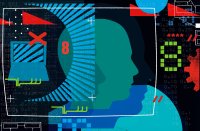The Connection Between Working Memory and Students’ Tech Skills
Teachers can boost elementary students’ developing tech skills by being mindful of the limitations of working memory.
Your content has been saved!
Go to My Saved Content.When I taught a fourth-grade class how to build a website using Google Sites, I began counting the directions I gave my students. There were many—I had a large amount of information in an extremely compact lesson. Even though I used colors, visuals, and examples to make the lesson more interesting, I noticed that some students shut down, overwhelmed by the amount of information. That experience led me to realize the importance of working memory.
Working memory enables students to combine multiple pieces of information in some novel form. Working memory asks students to pull information they learned in a prior lesson and mix it up as they apply it, which is especially crucial when using new technology because there’s no frame of reference that the student can use to retrieve prior knowledge. In my website lesson, students had the prior knowledge of academic content on the development of a site, but they had no prior knowledge of actual design or use of the website tool I was teaching.
Understanding working memory and helping students develop theirs can be a powerful way to improve student outcomes when teaching with technology.
Keep Directions Simple
Short-term memory issues occur when we simply run out of space in our brain. When too much new information is trying to enter, a student isn’t able to move forward with what they need to accomplish. A teacher might see a student freeze up at a point when the teacher thinks the answer is obvious.
Since tech demonstrations often have multiple, detailed steps, consider going through three steps at a time. Pause intentionally and chunk directions so that students can catch up on the task.
While we’re not able to increase a student’s working memory, teachers are able to strengthen it. If you are teaching computational thinking practices like pattern recognition, this can help strengthen academic memory and increase expertise.
Pay Attention to Energy
Energy issues can affect a student’s working memory: A sleepy student relies on visual novelties to keep their working memory going. The teacher’s trick is to balance stimulation and keep students alert without distracting them from the goal. Encouraging purposeful tools and avoiding downtime when students can randomly search without intent keeps them focused. A tool is purposeful if the teacher has directed students to practice using technology with a specific site or app while working toward a specified goal.
Teachers can boost students’ energy levels with movement, such as bringing technology outdoors with tools like The Walking Classroom, which offers audio lessons in the form of podcasts. If you can’t take students outside—or if students at home for distance learning can’t get outside—YouTube is now offering all kinds of brain breaks that can be found by searching for that term. These are similar in style to GoNoodle activities.
Limit Distractions
When students lack focus or are distracted, orientation issues in working memory appear. Orientation can be subdivided into internal or biological issues and external or environmental issues. Students who struggle to transition to a new subject area may have an external orientation issue. Techniques such as stretching between classes are really helpful and may improve students’ focus. Another way to limit distractions, which works whether you are live or virtual, is to use sound cues. For classroom teachers, this may look like programmed doorbells, and for virtual or hybrid teachers it may be a sound like a chime pulled from an online source.
One way teachers can limit visual distraction is to carefully consider what information needs to be accessed frequently—like an anchor chart for classroom norms—and what can be hidden away. At my school, we started with completely open shelving in the rooms, but we have since moved to having cabinets, storing certain items based on their likelihood of distracting students from current learning objectives.
Give students extra time to remind themselves of different behaviors in different settings. Before the pandemic, I would use techniques like reminding students that they were leaving my technology class while practicing some deep breathing and asking what kinds of behaviors they would work on for the next specialist or core class they had. Analyzing my own entrance and dismissal procedures meant giving the students more time to clean up and ease in and out of situations. This practice also alleviates extra stimulation for the next teacher who works with the students.
Working memory relies on executive attention, our ability to regulate our responses to situations. Executive attention issues surface in my work in makerspaces, computer labs, and computer science environments because we instructors display a wide range of available tools so that students have options. Those options can be so appealing that they affect students’ executive attention and how they make choices in their learning. I address this by regulating their choices, displaying only the tools that students will be working with during a particular unit.
One last thing teachers should focus on in supporting students’ working memory is repetition: It is especially important for those of us who are teaching virtually to remember that repetition is OK—repeating directions and explanations is a way to purposefully strengthen students’ working memory skills.
